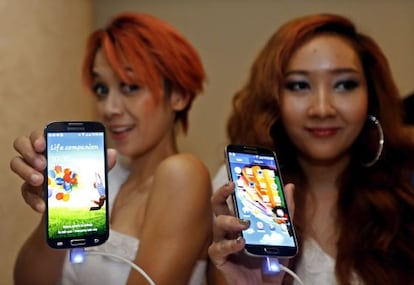Galaxy S4 beats iPhone on points
Apple’s smartphone can still hold its own against high-level competitors Company’s designs are increasingly similar but software makes the difference

Samsung’s hotly anticipated smartphone Galaxy S4, on sale for a week now, is just the latest in a series of mobiles that seek to stand up to Apple. The S4 evidences two trends: that screens are getting bigger, and that software increasingly makes the difference in a sector filled with models that tend to look alike. For now, the South Korean firm is the only one that’s on a first-name basis with Apple, but its new model will not have an easy time of it. In fact, it is fighting against itself, since it must outdo its maker’s most successful cellphone to date, the S3, with very similar specs.
How do you convince someone who has just spent over 600 euros to invest a similar amount yet again? Therein lies the challenge. There are no major changes from the S3 to the S4, at least physical ones. The screen has reached a five-inch display and the camera improves from eight to 13 megapixels, but the design remains identical, including the controversial plastic, which makes the device more lightweight. It is loved by some, hated by others. The battery improves from 2,100 to 2,600 mAh, but consumer frustration remains the same: it doesn’t last long. The greatest change with regard to the S3 lies inside, in the software.
This quick succession from one model to the next follows market laws. Eight months are an eternity in this world, and the renewal cycle gets ever shorter. Only Apple dares to challenge with its iPhone, although it sounds mostly like an excuse. There will be no new launches until September. Apple CEO Tim Cook insists that its handset is the best because of its ecosystem. The Apple applications store, App Store, remains unbeatable for now, and is about to surpass the 50-billion download mark, easily outperforming Android.
S4 is the latest in a new batch of cellphones that all target the same audience and have nearly identical price tags. They are all priced between 600 and 700 euros. Only the Nexus 4, which is peculiar on many fronts, is being offered for 300 to 350 euros, depending on whether one wants eight or 16 gigabytes of memory. The industry would rather maintain a similar figure year after year for the most advanced models and offer technical improvements rather than lower prices and compete amongst themselves. That is left to the midrange handsets. The problem is that for the same price, you still have the same problem a year later. Not one of these mobiles lasts an entire day away from a plug following reasonable use: a bit of social networking, browsing the news, reading mail, sharing photos and little else. In Apple’s case, dependency on the power grid — it has trouble reaching a whole morning’s worth of autonomy.
Is it better than the iPhone? Technically, perhaps yes
At first sight, they seem quite similar. HTC One and iPhone could pass off as brothers. Nexus 4 is a clone with a slightly smaller screen (4.7 to 4 inches) than LG’s Optimus G. Processing speeds are quite similar. They even share the same camera sensor and parts manufacturers. The only exception on this front is Sony’s Xperia Z, which shares similar specs but offers greater shock resistance (to moderate knocks) as well as improved resilience against water and dust. Each one of these handsets aims to convince consumers to buy them before the fall, when the race for renewal will begin all over again. These are the weapons in their respective arsenals.
Galaxy S4. Impressive to look at, familiar interface, a good camera and easy to use, especially if one has already used a Samsung in the past. To this we must add its own voice assistant, which does a much better job than Apple’s Siri. All right, so Apple invented it, but Samsung improved it. The most interesting part of the S4 are the programs that come with it, from S Health, a manager of sports activities and nutrition that does everything from counting steps and distances to telling users how much more they should have exercised to get rid of those excess calories from chocolate. Couch potatoes will be fascinated by the TV guide and by the fact that the handset doubles as a remote control, even if the TV set is not a Samsung.
Another good thing is the way the screen is used to full advantage by showing two programs simultaneously — one floats over the other. The phone can figure out how much each diner should pay at a group dinner while simultaneously running a video. The S4 also has a barometer, a temperature gauge and a few other sensors that are out of the ordinary. For instance, the phone can tell whether one is no longer looking at the screen and stops a video; it can also tilt screen content if it perceives that the user is lying on a sofa.
Is it better than the iPhone? Technically, perhaps yes. But Apple still gets points for its halo of exclusiveness, its unbeatable list of programs and its ease of use. Although it is also true that Android’s interface is a lot cleaner and clearer ever since version 4.0 came out.
Optimus G. LG’s flagship handset comes close to the five-inch mark with a screen that is broad and sensible. It is easy to use and offers a no-frills version of the operating system. Direct accesses are very well thought-out. One of its best features is the way the camera offers early, rapid-fire shots of the image you want to capture before you actually press the button. This is perfect to avoid missing a child blowing out birthday candles or a funny slip on the snow.
One. HTC has set all its hopes on the One. Support from operators is helping it take off. It also has a few notable virtues, like a camera that performs like no other in low light, social network updates displayed on the home screen, and a robust case.
Nexus 4. The favorite of tech enthusiasts has no advertising and no promotion. While it is made by LG, this is not made explicit. We are talking about the handset that was tailor-made for Google to show the way to other manufacturers. The goal is not so much making money as showing app developers how the OS works without additives. The camera is mediocre, but the rest makes up for it. The drawback is that it is only sold online through the Google search engine, and it can take up to five weeks for delivery.
Conclusion. Despite so much on offer in the high end of the smartphone market and the difficulties making a choice (we could add Nokia’s Lumia or Sony’s Xperia Z), often enough the decision is aided by the operators. Apple, which gives telephone companies less leeway, still prices its handsets slightly higher despite the contracts. Anyone who wants a contract-free phone should no doubt opt for the Nexus 4, which offers nearly the same things but for half the price. There are no marketing, advertising or promotional expenses to drive up the price. The others are quite similar and the choice will depend on the taste, or the phobias, of each particular consumer, or else on the operators’ best offers.
Tu suscripción se está usando en otro dispositivo
¿Quieres añadir otro usuario a tu suscripción?
Si continúas leyendo en este dispositivo, no se podrá leer en el otro.
FlechaTu suscripción se está usando en otro dispositivo y solo puedes acceder a EL PAÍS desde un dispositivo a la vez.
Si quieres compartir tu cuenta, cambia tu suscripción a la modalidad Premium, así podrás añadir otro usuario. Cada uno accederá con su propia cuenta de email, lo que os permitirá personalizar vuestra experiencia en EL PAÍS.
En el caso de no saber quién está usando tu cuenta, te recomendamos cambiar tu contraseña aquí.
Si decides continuar compartiendo tu cuenta, este mensaje se mostrará en tu dispositivo y en el de la otra persona que está usando tu cuenta de forma indefinida, afectando a tu experiencia de lectura. Puedes consultar aquí los términos y condiciones de la suscripción digital.







































